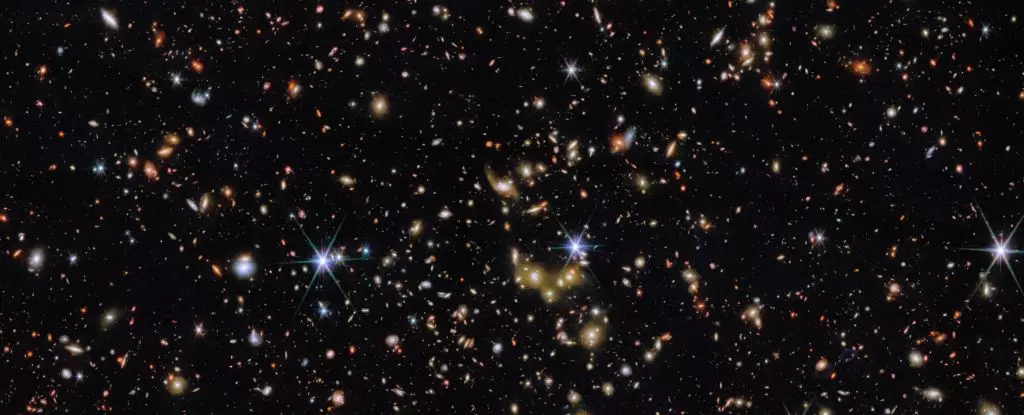In an era where cosmic exploration thrives, the James Webb Space Telescope (JWST) has unveiled a striking image that redefines our understanding of the universe. Gazing into a minute corner of the sky, equivalent to less than one-fifth the width of the full Moon, the JWST has captured a breathtaking vista of distant galaxies, a sight that accelerates the heart and ignites the imagination. This awe-inspiring deep-field image allows us to catch a glimpse of the universe as it was nearly 12 billion years ago, underlying the inconceivable vastness of space and time.
In this tiny patch of cosmic canvas, the JWST has acted as a time machine, revealing a congregation of not merely twinkling stars, but entire galaxies that have existed for eons. Each of these galaxies is a testament to the grandeur of cosmic evolution, a sparkling beacon forged through time and the forces of nature. Unlike point-like stars, which in JWST images exhibit notable diffraction spikes, the countless galaxies appear as softer, more diffuse lights. This distinguishing feature is critical in interpreting the universe’s layout; it allows astronomers to differentiate between foreground stars and background galaxies seamlessly.
The Cosmic Tapestry and Its Architectures
At the core of this incredible image lies a captivating group of galaxies, radiating a resplendent golden hue that hints at their ancient, fiery histories. The light arriving from this group has traversed the cosmos for about 6.5 billion years, making it nearly half the age of the universe itself, which is estimated to be about 13.8 billion years old. Such data derives from the COSMOS-Web survey, an ambitious project dedicated to cataloguing galaxies in order to illuminate their connection and evolution throughout the universe.
An understanding of how galaxies distribute themselves reveals much about the fabric of the universe. Generally, galaxies exhibit a remarkable tendency to congregate into clusters, interconnected by an enigmatic cosmic web composed of dark matter and hydrogen. The components of this web sculpt the pathways for galaxies, indicating that the distribution of these celestial bodies is anything but random. The synergy between the JWST’s observations and X-ray data from the Chandra X-ray Observatory highlights the staggering size of the clustered group detected and the vast amounts of hot gas that surround them, detectable through Chandra’s powerful instruments.
Astonishing Discoveries Beyond the Immediate View
However, the true marvel extends beyond what initially meets the eye. When analyzing data from this image, an international team led by astrophysicist Greta Toni has cataloged an astonishing 1,678 groups of galaxies within this section of sky. This cataloging not only underscores the richness of this particular area but also provokes excitement about what other untouched patches of the cosmos may reveal. The scope of this exploration implies that countless similar clusters of galaxies lurk in the universe, waiting to be unveiled.
To put it into palpable context, this 6.44 by 6.44 arcminute segment of sky, home to the 1,678 groups of galaxies, is astoundingly small. The entire circular surface of the full Moon encompasses around 30 arcminutes, suggesting that if we were to magnify particular patches of sky across the universe, each could potentially be as bustling as this one—swirling with galaxies, cosmic structures, and myriad stories yet to be discovered.
Reflections on Our Place in the Universe
This breathtaking JWST imagery serves as a poignant reminder of our position in the grand scheme of existence. The light from these ancient galaxies, now reaching us after trillions of moments, tells a tale of cosmic history that transcends human experience. It inspires a whirlwind of questions about our own origins, our fate as a species, and the continual ebb and flow of existence itself.
In a world often consumed by minute perspectives and daily worries, peering into the depths of the universe’s past offers a humbling experience. It invites us to embrace awe, reflecting on the interconnectedness of all things, and encourages a deeper appreciation for the quest for knowledge that propels us into the starry night. In the face of such cosmic treasures, we are left both small and remarkably significant, as we become witnesses to the universe’s unfathomable journey.


Leave a Reply